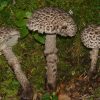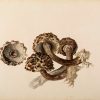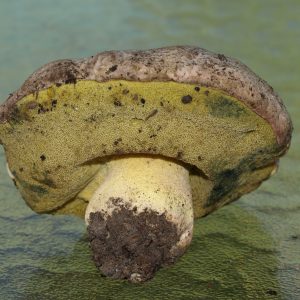Description
Name in North American Boletes: Strobilomyces floccopus
Genus: Strobilomyces
Species: strobilaceus
- Species 2: floccopus
Common Name: Old Man of the Woods
Tells: Cap has distinctive black scales on white base. Flesh stains pink. Stem is often stringy & useless.
Other Information: Spore print edges toward black. When cooked, will stain a pot of food dark or black. NOTE: The books say its maximum size is 6″ in diameter, but we have personally found more than one specimen in Pittsburgh that was at least 9″ across. NOTE: The drawing is indeed from the Beatrix Potter of Peter Rabbit fame, who was an accomplished amateur mycologist.
You pretty much need chemical or microscopic tests to tell the three types of Old Man apart and it makes no difference from a practical point of view. These are rules of thumb:
- dryophilus tends to have a lighter stem & scales that are grayish pink instead of grayish black;
- confusus tends to have stiffer & pointer scales; and
- strobilaceus is the most common & often has a distinct ring zone on the stem.
Science Notes: DNA testing has led the authorities to move this mushroom back from “floccopus” to its old, European species name.
Edibility: Good.
CHEMICAL TESTS:
- NH4OH (Ammonia): Cap skin turns brown. Cap flesh turns dark yellow-orange, edging toward brown.
- KOH: Cap skin turns dark reddish brown.
- FeSO4 (Iron Salts): Cap skin turns brown. Cap flesh turns bluish gray.
Links:
 |
580 |  |
308 |  |
225 |  |
307 |








Got something to discuss?